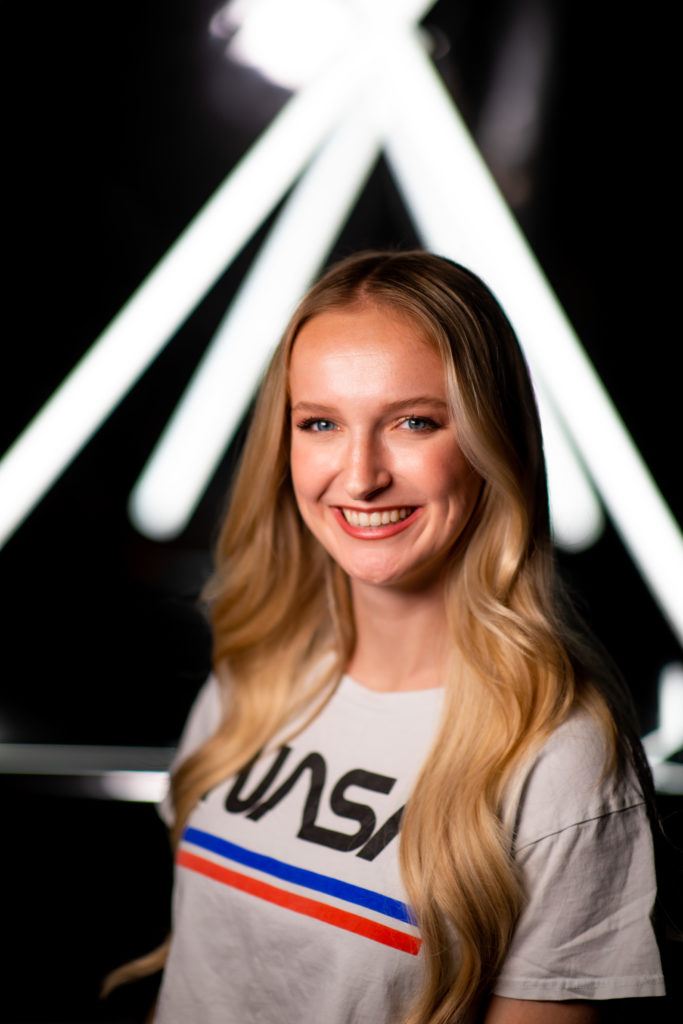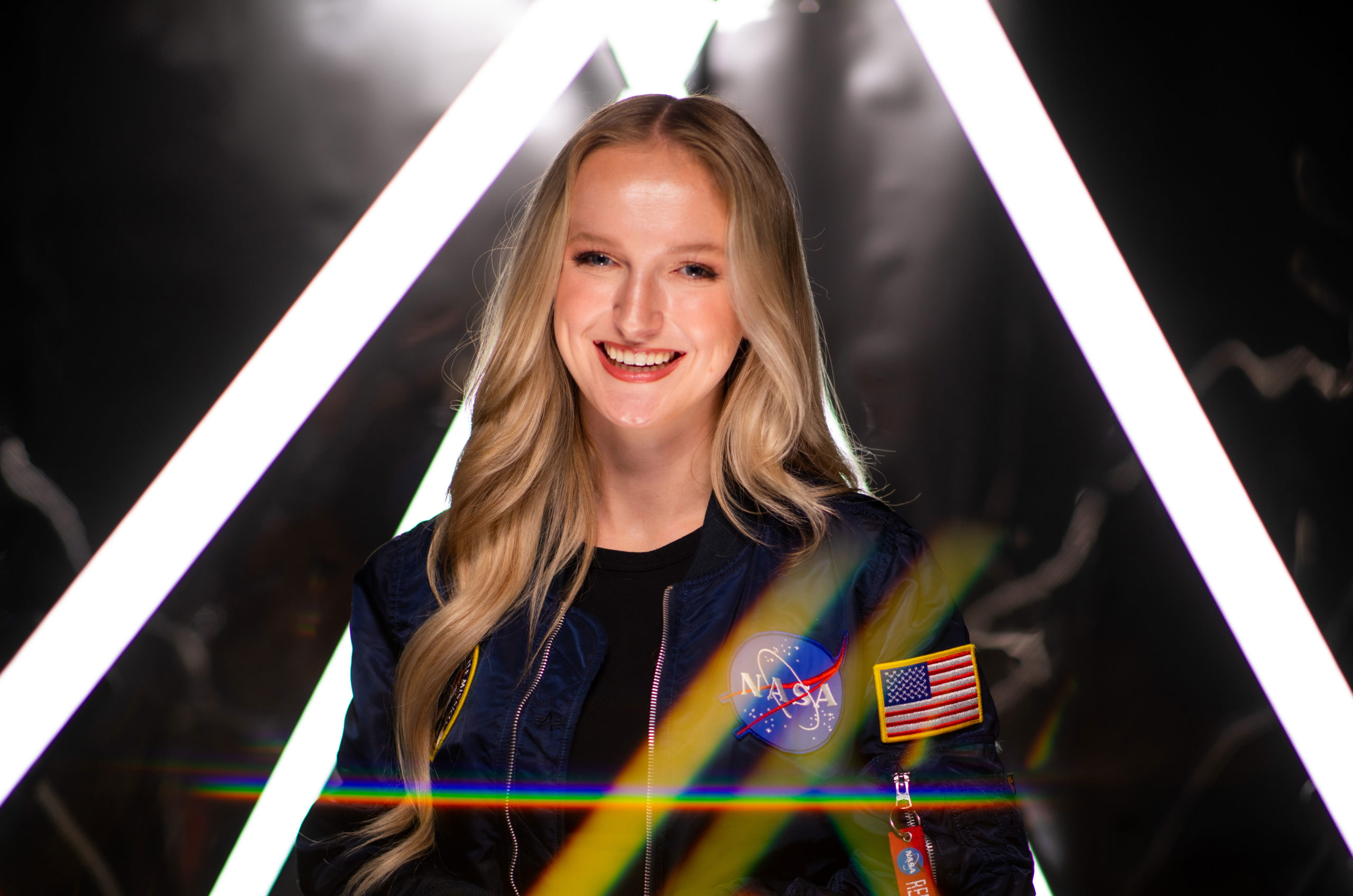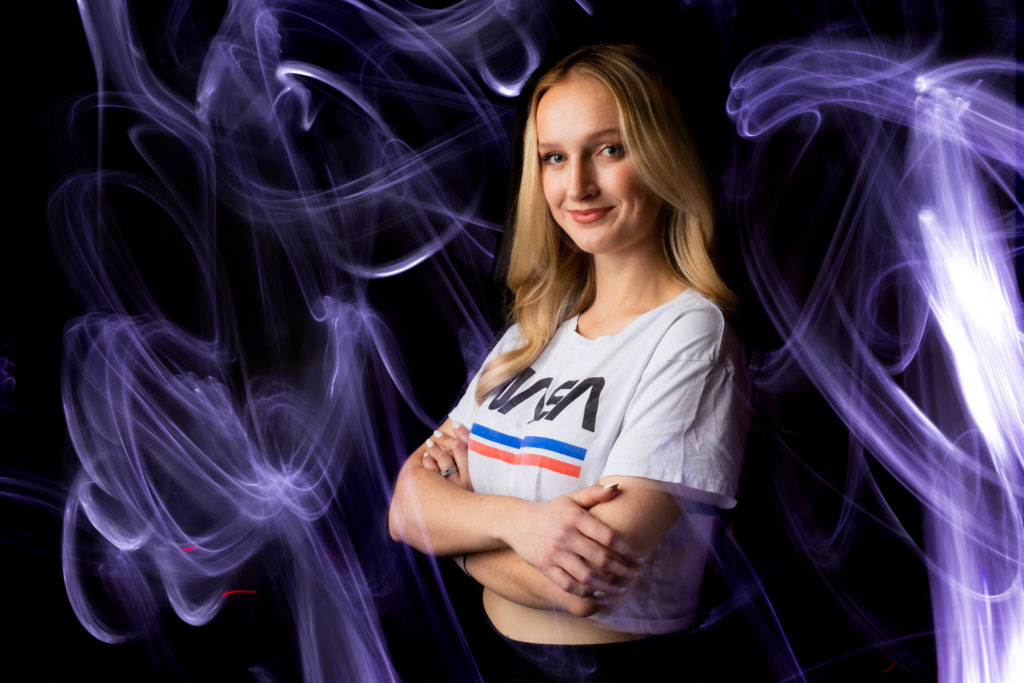Camille Bergin tumbles through the air like a gymnast. Her long blonde hair floats seconds longer than it should, moving as if she were underwater. For eight minutes she is weightless in the Colorado sky, fulfilling a dream she’d had since she was four years old when she watched from the top floor of a parking garage in Florida as the Space Shuttle Endeavor broke through the sky.
In January 2021, Bergin was invited by Matt Gohd, CEO of the Zero Gravity Corporation, to join him aboard the company’s aircraft for that flight, which is captured on video and has been viewed more than 18 million times on Instagram. Bergin had one stipulation: she wanted to take someone with her—free of charge.
“My platform is all about making space accessible to everyone,” says Bergin, a 2019 aerospace engineering graduate who has built a following of nearly 260,000 people on TikTok and 85,000 on Instagram as @TheGalacticGal, which is dedicated to educating people about science, technology, engineering, and mathematics and to empowering girls and women in those fields.
Gohd covered half of the more than $8,000 ticket for the weightless flight, with Bergin raising the rest. A contest was set up, with entrants submitting 30-second videos making a case for why they should be the person to join Bergin on the flight. The winner was Badhon Tithi, a Bangladeshi American mechanical engineering student from New York City who spoke about her dream of making it to space one day and what that achievement could mean for other South Asian women. “In my community,” she says, “you don’t see people who look like me doing these crazy, ambitious things.” Tithi had been following the Galactic Gal and found Bergin’s posts uplifting and relatable—like taking a microscope to see up close what life could look like for her as a woman in the space industry. “It’s very empowering and impactful to see someone living a life that you want,” Tithi says. “It was almost like affirmation that I could do it too.”
Bergin grew up in rural western North Carolina, where encountering women in the engineering and space industries was rare. Her role models were fictional, like Jodie Foster’s character in the film Contact—which Bergin has watched a hundred times, thinking one day she might also explore the outer reaches of space for signs of extraterrestrial life. With post-graduation depression and the pandemic taking their toll, Bergin started the Galactic Gal in spring 2020 as a form of connection—an antidote to the chaos happening around her. It didn’t take long before it took on greater significance. Through it, Bergin realized she could bridge the knowledge gap for others like her who lacked role models in the fields they hoped to pursue.
“If I had seen something like this as young girl, and even into my teenage years, I would’ve known a lot earlier in life that I could be an aerospace engineer or an astronaut,” Bergin says.
 The video of Bergin and Tithi’s weightless flight has been her platform’s most popular post. One viewer was Farragut High School senior Hailey Henderlight who, like Bergin and Tithi, hadn’t grown up around engineers but loved astronomy. After being admitted to UT’s Tickle College of Engineering, she was considering an aerospace major. One afternoon, while scrolling through the Galactic Gal page, Henderlight realized that the woman she had been following on social media wasn’t some distant star.
The video of Bergin and Tithi’s weightless flight has been her platform’s most popular post. One viewer was Farragut High School senior Hailey Henderlight who, like Bergin and Tithi, hadn’t grown up around engineers but loved astronomy. After being admitted to UT’s Tickle College of Engineering, she was considering an aerospace major. One afternoon, while scrolling through the Galactic Gal page, Henderlight realized that the woman she had been following on social media wasn’t some distant star.
“She was someone who had been in the same classes I was going to take, and she had graduated and been successful,” Henderlight says. That sealed the deal: Henderlight declared her major soon after. “Camille Bergin is such a large part of why I’m here.
On March 28, Bergin spoke on campus about humanity’s return to the moon. The event was organized by the Women in Engineering program and the Society of Women Engineers.
During a break, Henderlight met her role model in person. “It was surreal,” she says. The next day, they spoke again at a small luncheon for faculty and students. Henderlight asked Bergin questions about the major and what it’s like working on the business side of the space industry. She shared her own goals, too. Bergin listened patiently and reassured her. As she had with Tithi, she let Henderlight have a look into the microscope.
“I’m not here to be an influencer,” Bergin says. “I’m here to actually help people.”
A Path to the Stars
Bergin’s own journey could have turned out quite differently if not for a campus visit that sealed her decision to come to UT.
Then a nationally ranked trumpet player in the high school program at the University of North Carolina School of the Arts, Bergin toured UT as a sophomore in high school. She met with now-retired trumpet professor Cathy Leach in the School of Music before touring the math department. But Bergin had come to UT only at the urging of her father. Her sights were set on Carnegie Mellon University. Knowing of his daughter’s fascination with space—their family had once spent an entire summer watching seasons of Stargate together—her father suggested they make one final stop on campus.
Within minutes, they were in Masood Parang’s office in Perkins Hall. Even though they didn’t have an appointment, Parang, then associate dean of academics and student affairs in the College of Engineering, stopped what he was doing and invited them in. Over the course of an hour, he explained everything the college had to offer, including the opportunities available through its highly ranked aerospace program and its efforts to attract and retain women students. The college had established a living and learning community exclusively for women in engineering majors, and Bergin liked the idea of having other women around to support her.
“That’s when I decided: I’m going to Tennessee. I’m going to be an engineer—specifically, an aerospace engineer. And I’m going to be good at it,” Bergin says.
By the time she had to make a college decision two years later, her acceptance letter from Carnegie Mellon was an afterthought.
I just felt at home at Tennessee. I knew I was going to be supported. And that’s all because Dr. Parang took one hour of his day to talk to me when I was 16 years old.”
While moving onto the women’s engineering floor in Morrill Hall that summer, Bergin met Gillian McGlothin, who would become her best friend and later the maid of honor at her wedding. Four years later, Bergin and McGlothin—now an application support engineer for MathWorks—would graduate as the only two women aerospace engineers in a class of 31. (According to the Association Society for Engineering Education’s last count, 14 percent of undergraduate aerospace engineering degrees nationwide in 2019 were awarded to women).
“It was very empowering,” says McGlothin about that first year living on a floor full of other women taking the same classes and facing the same challenges. “A lot of us were from out of state, so we didn’t have high school friends going to UT. We joined the LLC as a way to meet people. The personalities that were drawn into that group—we were all very driven women.”
Bergin became an Engineering Ambassador, leading campus tours and conducting outreach at area high schools for the college. Her boldness was apparent to everyone around her. Her sophomore year, at a Board of Advisors’ meeting, which are regularly attended by ambassadors, Bergin approached the retired president of Pratt & Whitney’s military engines business, Bennett Croswell, to ask about his company, career path, and opportunities that might be available to her. She did the same a year later with Ralph Heath, retired executive vice president of Lockheed Martin Aeronautics. Bergin wound up with internships at both companies.
“That was just Camille being Camille,” says Lisa Byrd, associate director of engineering advising and supervisor for the Engineering Ambassadors program. “She’s such a testament to the kinds of opportunities students build for themselves in our college, and the joy they could have in engineering.”
Besides graduating top of her aerospace class, Bergin played trumpet for two years in the Pride of the Southland Band, was a member of the Chancellor’s Honors Program, and served as chair of UT’s American Institute of Aeronautics and Astronautics chapter.
“That was my baby,” says Bergin. “My pride and joy.”

In two years, she helped grow AIAA from a dozen to more than 100 students, organizing trips for students to Boeing’s headquarters in Charleston, South Carolina, and the Lockheed Martin Aeronautics facility in Marietta, Georgia—both funded in part by the sale of merchandise. Matthew Mench, who was head of the Department of Mechanical, Aerospace, and Biomedical Engineering and is now dean of the Tickle College of Engineering, was so impressed that he began sharing Bergin’s approach as a template for other student organization leaders to follow.
Perhaps most impressive, however, was Bergin’s ability to shift the image of what an engineer—what a literal rocket scientist—is. Yes, she is smart. But she’s also charismatic, curious, and entrepreneurial: a role model for girls who love spaceships and aircraft but aren’t sure what it would take to operate them one day.
“There are a lot of fantastic female aerospace engineers out there,” Mench says. “But it’s not the stereotype. So when you have somebody like Camille, who is a graduate of your program, go out there and break down those stereotypes of what an engineer is, it opens the door for others.”
Today, as the Galactic Gal, Bergin posts videos that answer the questions kids, their parents, and college engineering students have about the latest in space exploration or NASA technology. She shares pictures of what she wears to work—outfits that are flashier than the all-black “power suits” she, McGlothin, and their crew of women engineering students once wore to career fairs. But she also discusses more serious topics like her struggles with perfectionism, mental health, and work–life balance. Watching her friend’s videos, McGlothin recognizes the candor in her voice; she’s walked through so many of the same challenges herself.
“So much of the time on social media, it’s really easy to only show the best snapshots of everything—which is obviously not reality. But we forget that sometimes,” McGlothin says. “I think people relate to Camille’s honesty. It’s not just ‘Here’s a cool rocket launch.’ The vulnerability she shows when she talks about her experiences as a woman in engineering just makes people feel more connected to her.”
Paving the Way
Two years into life as the Galactic Gal, Bergin posts multiple times a day on Instagram and TikTok. Her coverage of space news—like her post on March 31 about the Hubble telescope’s spotting of the most distant star ever seen in outer space, and her announcement shortly afterward that she had been invited to watch the SpaceX Crew-4 mission, a four-crew member science expedition to the International Space Station—is determined by this question: what would she have benefited from seeing when she was growing up?
Dozens of messages from followers flood her inbox every week. Many are declarations (“I had no idea there were women doing this!”). Others, especially from some of her younger followers, are questions: “I feel like I’m not cut out for math—is that OK? Can I still be an engineer?” “How do I get involved with space if I don’t live near a NASA center or an aviation museum?” “What can I do now to set myself up for success in college and after?”
She regularly receives a question from engineers considering career transitions: “Is there a path in the industry for someone who’s tried traditional engineering after college and didn’t like it?”
“Yes, yes, there is,” she tells them.
Until the summer of 2020, Bergin had been a systems engineer for Lockheed Martin. She was working on the Orion spacecraft that will take humans back to the moon, something she had long dreamed of doing. But she struggled with being alone in front of a computer screen all day coding or working with CAD models. A mentor suggested she consider transitioning into business development; Bergin’s in-depth knowledge of the industry and its technology would be just as valuable to companies thinking about the future of aerospace and the innovation and partnerships needed to move it forward. That August, Bergin moved into a business development role at Lockheed Martin. She was then sought out to work for Orbit Fab, a start-up seeking to build an in-space propellant supply that it’s promoting as “gas stations in space.” She has been there since November 2021.

“At the end of the day, there are so many things you can do with an aerospace engineering degree,” Bergin says. “Part of my platform is helping people realize they can still be whoever they are—they don’t need to fit what they think of as the traditional mold of an engineer. They can bring all of their personality to the table, and there will be a place for them in the industry.”
During Bergin’s UT visit in March, about a hundred students packed into a room to listen to her recount her experiences as a student, aerospace engineer, and social media personality. The talk was high energy, one of the best Bergin says she’s done. Many of those in attendance were female engineering students, probably looking, as Bergin once had, for someone to show them what they dream of could be realized.
“One reason female students don’t persist in engineering is access to role models,” says Jalonda Thompson, director of UT’s Women in Engineering program. “Seeing female engineers like Camille can help them connect the dots between things they are good at and future possibilities within and beyond engineering.”
Tithi, who joined Bergin on the weightless flight in Colorado, credits that experience with giving her the confidence to land a full-time job at SpaceX, where she’s now an avionics system engineer.
Camille showed me that if you believe in something, and you work hard towards it, it doesn’t matter what you look like. If you put your heart and soul into it, and you stick it through, anything is achievable.”
The best is likely yet to come for Bergin and for the Galactic Gal platform. Maybe years from now it will be Henderlight, currently a student assistant with Women in Engineering, advising the next generation on how she made it to Lockheed or NASA. Or Tithi telling students that she may have been the first Bangladeshi American woman to fly among the stars, but she certainly won’t be the last. And decades into the future, there will be this to thank: a decision by Bergin to share with the world her belief that space is for everyone, regardless of how far they’re born from a rocket site, how many people who look like them attend engineering school, or what color power suit they rock at a career fair.
“You know, social media can look very vain at times,” Bergin says. “But it can also be incredibly empowering and life-changing. Sharing everything I’ve experienced with other people has been really, really rewarding to me. It’s radically changed my life.”


1 comment
What a fantastic and inspiring article. I was tickled by the name Galactic Gal. I used to read an off-beat comic book called Galactic Girl Guides, sort of like Girl Scouts in Space back in the day. Best of luck to Camille and all women in engineering.